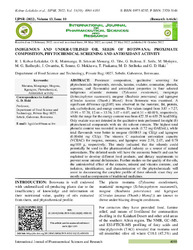| dc.identifier.citation | Kobue-Lekalake, R. I., Matenanga, O. K., Sekwati-Monang, B., Tibe, O., Bultosa, G., Seifu, E., ... & Haki, G. D. INDIGENOUS AND UNDER-UTILISED OIL SEEDS OF BOTSWANA: PROXIMATE COMPOSITION, PHYTOCHEMICAL SCREENING AND ANTIOXIDANT ACTIVITY.13(10): 4093-4101International Journal of Pharmaceutical Sciences and Research. | en_US |
| dc.description.abstract | Proximate composition, qualitative screening for phytochemicals (terpenoids, steroids, tannins, oxalates, coumarins, phenols, saponins, and flavonoids) and antioxidant properties in four selected indigenous oilseeds: morama (Tylosema esculentum), mongongo (Schinziophyton rautenenii), mogose (Bauhinia petersiana) and kgengwe (Citrulus lanatus (Thunb.) Mansf.) from Botswana was examined. A significant difference (p≤0.05) was observed in the moisture, fat, protein, ash, carbohydrate, and energy contents. The values ranged from 3.87 – 7.27, 15.99 – 57.70, 12.44 – 33.76, 3.07 – 6.07, and 6.31 – 60.01%, respectively, while the range for the energy content was from 422.35 to 655.29 kcal/100g. Only oxalate was not detected in the qualitative tests performed for eight (8) phytochemical compounds with six (6) solvent extracts. The highest total phenolic content was recorded in morama seeds (1.72 mg GAE/mL), while total flavonoids were better in mogose (0.00813 mg CE/g) and kgengwe (0.00404 mg CE/g). The vitamin C equivalent antioxidant capacity (VCEAC) for mogose, morama, and kgengwe were 2.39, 2.07, and 0.78 mg/100 g, respectively. The study indicated that the oilseeds could potentially be used in the pharmaceutical industry as a source of natural antioxidants. The defatted seeds will have the economic benefit and can be exploited to develop different food products, and dietary supplements to prevent some mineral deficiencies. Further studies on the quality of the oils, the antimicrobial effect of the extracts, mineral and vitamin contents, and isolation, identification, and characterization of the phytochemicals will assist in documenting the complete profile of these oilseeds since they are mostly used as components of traditional medicines. | en_US |

